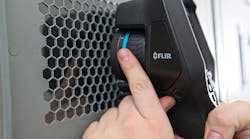A new era has arrived for electrical equipment maintenance, and worker safety is predominant. The days of suiting up in personal protective equipment (PPE) and hoping for the best are over. The NFPA 70E which deals with how to reduce risk through safe work practices on equipment under “abnormal” conditions and when the likelihood of shock exposure, arcing fault and arc flash are heightened have been updated. One of the standout features, The Hierarchy of Risk Control Methods are no longer optional; they have been made mandatory. These requirements apply to any energized electrical work task to help mitigate exposure and reduce risk. The Hierarchy must be applied in sequence to eliminate the inherent risk or reduce it to as low as reasonably practicable. The Hierarchy of Risk Control is made of 6 control levels – Elimination, Substitution, Engineering Controls, Awareness, Administrative, and Personal Protective Equipment (PPE). Each control level must be considered fully and eliminated as an option before moving to the next lower, less effective control within the hierarchy.
For many routine maintenance inspections, thermal imagery has become a staple analytical and diagnostic tool. “With thermography, we can’t see through a cabinet, equipment must be energized and operational and we need to see the connection directly in order to see a hot spot,” Lammert explains. “So, we need to do it either with the door open, energized, and with the proper PPE on; or we can install IR windows which minimizes the worker’s exposure to risk.”
Adding IR Windows to panel covers or electrical cabinets allows technicians to efficiently perform thermal imaging inspections on energized equipment under “normal conditions with all hinged doors closed, covers on and guards in place; workers exposure to any hazard(s) has been greatly reduced. IR Windows protect workers against arc flash accidents because they maintain a sealed barrier between the worker and the connected equipment.
Hierarchy of Control
One key aspect of NFPA 70E is the addition of a risk assessment procedure. Risk assessment involves identification of hazards, assessment of the risks, and implementation of risk control based upon NFPA’s “Hierarchy of Risk Control Methods.” Elimination of risk is the most effective control method. The remaining control strategies ranked in order from most to least effective are:
- Substitution
- Engineering Controls
- Awareness
- Administrative Controls
- PPE
IR Windows may be considered either “Substitution” or an “Engineering Control” procedure, dependent upon a facility’s risk assessment. IR Windows may fall under “substitution” if workers identify the opening of panels as a hazard. In this instance, the IR Window would qualify as an effective substitution versus opening the panels, Lammert emphasizes. In another example, if the hazard is high voltage inside the panel, the IR Windows could be considered an “Engineering Control”. “In either instance, IR Windows allow you to move much higher up the Hierarchy of Controls than utilizing PPE alone. That’s a key point of emphasis for NFPA – removing the risk to the point of elimination,” Lammert states.
Window Shopping
Thermal imaging solutions provider, FLIR Systems, expanded their assortment of IR Windows in 2018 to include large format windows. The IRW-xPC and IRW-xPS are impact-resistant, rectangular, polymer windows which come in 3-standard sizes (6, 12, or 24-in.). Designed for harsh environments, these windows are proven compatible with acids, alkalis, UV, moisture, humidity, vibration, and high-frequency noise. FLIR System’s large format window provide the greatest amount of viewing area currently available to monitor inside energized electrical equipment.
FLIR Systems also offers the more traditional circular format IR Windows in 2, 3, or 4-in. sizes; in either aluminum or stainless-steel finishes. IR windows installation is not a complex process. Lammert compare it to adding a conduit to a panel. Users need to insert a threaded base through a hole and tighten a screw-on ring nut. FLIR provides a sizing table to help organizations determine the correct hole size. The sizing tools help users understand how much area they can view through a given window. One data center that installed FLIR circular IR Windows completed the installation in less than three hours using cut-out templates and cutting tools provided by FLIR.
Safer and More Efficient
After installing IR Windows, facilities typically experience faster, less costly inspections than using open-door thermography. When IR Windows are not present, thermal imaging typically requires up to two additional workers to remove and reinstall the doors. The technician may also need time to dress in bulky PPE gear, Lammert explains. “Also, the thermographer must wait for the cover/panel removal prior to inspecting and then again wait while the cover/panels are being reinstalled before moving to the next piece of equipment,” Lammert states.
Lammert emphasizes, that another benefit of IR Window implementation is increased reliability. Workers should be able to inspect electrical equipment more frequently and potentially inspect more components in situations where the voltage was too high for an open-door inspection.
IR Windows, either rectangular or circular, are a win-win. They help companies comply with NFPA 70E standards, increase worker safety, decrease preventative maintenance costs while potentially increasing frequency and scope.











